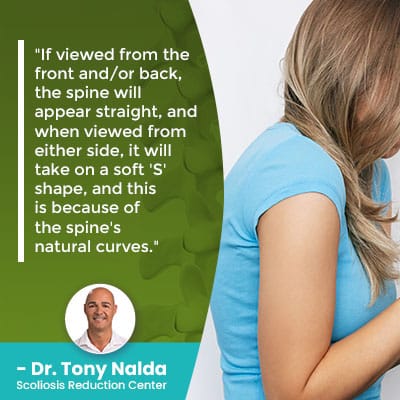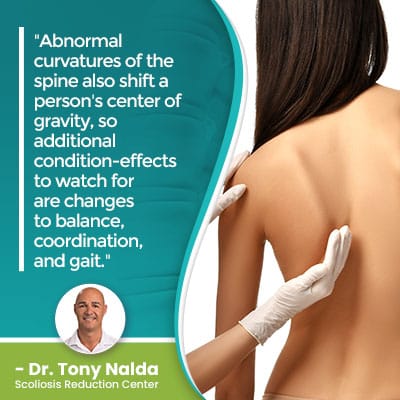Normal Spine Curve: Is A Curved Spine Normal?

While a healthy spine will have natural curves that mean its vertebrae are aligned as they should be, there are a number of spinal conditions a person can develop that involve a loss of the spine's healthy curves. Continue reading to learn more about some of these common spinal conditions, and why the spine is naturally curved in the first place.
The spine has natural and healthy curves, and maintaining those curves is key to optimal spinal health and function. If an unnatural spinal curve develops, it can disrupt spinal biomechanics and introduce a lot of uneven forces to the spine, its surroundings, and the entire body.
Let's start our exploration of healthy, and unhealthy, spinal curves with some spine basics.
Table of Contents
Anatomy of a Healthy Spine
When a spine is healthy, its vertebrae (bones) are stacked on top of one another in a straight and neutral alignment, and adjacent vertebrae are separated by healthy and hydrated intervertebral disks.
The spine's intervertebral discs are key structures; they act as the spine's shock absorbers, provide cushioning between adjacent vertebrae to prevent friction during movement, give the spine structure (vertebrae attach to the disc in between), and they combine forces to facilitate spinal flexibility.
When the spine starts to degenerate, it's most often the discs that are the first structures to feel the effects of deterioration, so when it comes to the development of a number of spinal issues/conditions, degenerative disc disease is often a contributing factor.
If the vertebrae are aligned as they should be, this means the spine's natural and healthy curves are in place in each of the spine's main sections: the cervical spine (neck), thoracic spine (middle/upper back), and lumbar spine (lower back).
The health of each section's curve is dependent on the health of the others; in fact, it's not uncommon for the spine to respond to the development of one unhealthy curve with the addition of a compensatory curve, in an attempt to counteract the uneven forces generated by the first unnatural spinal curve.
 If viewed from the front and/or back, the spine will appear straight, and when viewed from either side, it will take on a soft 'S' shape, and this is because of the spine's natural curves.
If viewed from the front and/or back, the spine will appear straight, and when viewed from either side, it will take on a soft 'S' shape, and this is because of the spine's natural curves.
The spine's natural curves make it more flexible, better able to handle mechanical stress, and stronger, like a coiled spring.
There are two main curvature types that can become under- or over-pronounced and problematic: kyphosis and lordosis.
Kyphotic and Lordotic Curves of the Spine
Kyphosis refers to the curvature of the thoracic spine that bends outwards, away from the body's center, and the cervical spine and the lumbar spinal sections both feature lordotic curves that bends inwards, towards the body's center.
Now, there is a natural range of curvature degree in both a kyphotic curve and a lordotic curve, but if a curvature size falls beyond a normal range, the once normal curvature of the spine has become excessive, and an abnormal curvature of the spine.
A healthy range of cervical lordosis would fall between 20 and 40 degrees, and a healthy range of lumbar lordosis would fall within a range of 20 to 60 degrees; thoracic kyphosis should fall between 20 and 40 degrees.
If one of these curves becomes excessive, it disrupts the spine's biomechanics, and a person can be diagnosed with hyperkyphosis or hyperlordosis.
In order to be treated effectively, the condition's underlying cause has to be determined, and treatment plans are designed around it, and a number of other important patient/condition variables; for example, there are different types of kyphosis with very different treatment needs.
Postural kyphosis is a simpler type to treat because it's a non-structural condition, meaning it's not caused by a structural abnormality within the spine itself, whereas Scheuermann's kyphosis, as a structural condition, features a rigid curve that needs to be impacted on a structural level.
In cases of congenital kyphosis, babies are born with the condition because of a malformed spine that developed in utero, so the fact that it's a structural condition, combined with the unique challenges associated with treating patients of such a young age, make this a particularly-complex type to treat.
Let's now address what happens when the leading spinal condition amongst school-aged children causes the development of an unnatural sideways spinal curvature.
The Scoliotic Spine
Scoliosis involves the development of an unnatural lateral curvature of the spine that also rotates, making it a complex 3-dimensional condition; a scoliotic spine doesn't just bend unnaturally to the side, it also twists from back to front, front to back.
In addition, scoliosis is progressive in nature, meaning it's virtually guaranteed to get worse over time, and this means the unnatural spinal curve will get larger, increasing the condition's uneven forces being introduced to the body, and their effects.
As scoliosis progresses, the condition's uneven forces disrupt the body's overall symmetry and can cause uneven shoulder blades, hips, and make it difficult to practice good posture and stand upright for extended periods of time.
In adults, for whom scoliosis is compressive, scoliosis will become more painful as it becomes more severe.
The Importance of Scoliosis Treatment
All forms of scoliosis require treatment because although there are different condition types, they are all progressive.
 Abnormal curvatures of the spine also shift a person's center of gravity, so additional condition-effects to watch for are changes to balance, coordination, and gait.
Abnormal curvatures of the spine also shift a person's center of gravity, so additional condition-effects to watch for are changes to balance, coordination, and gait.
If scoliosis is left untreated, it can become more severe, and as progression occurs, the spine gets increasingly rigid, less responsive to treatment, and the condition's effects are more overt.
While there are no treatment guarantees, it's far more effective to proactively work towards preventing progression and increasing condition-effects, than it is to attempt to reverse them once they've developed.
In general, it's also the area of the body located closest to the affected spinal section that's going to feel the majority of the condition's direct effects; for example, scoliosis that develops in the lower spine is going to mainly affect the lower back and body.
If scoliosis is left untreated and becomes severe, for those undergoing traditional scoliosis treatment, they are commonly funnelled towards invasive surgical treatment; fortunately, there is a less-invasive treatment option available, and the reality is that many cases of scoliosis can be treated successfully without surgery.
Part of the reason that spinal conditions can affect the body in so many different ways is that the spinal cord within partners with the brain to form the body's central nervous system: a vast communication network that facilitates brain-body communication.
So in one way or another, the spine is involved in the function of virtually every part and working system within the body, and if scoliosis is causing the spinal nerves to become compressed, it can cause pain and strange sensations felt anywhere along an affected nerve's pathway.
If a scoliotic spine is not addressed, it can continue to progress, disrupt movement, and can cause related complications such as digestive and breathing issues, and for adults, increasing levels of pain.
Scoliosis treatment that's proactive can prevent progression, increasing condition-effects, and the need for invasive surgical treatment in the future, and this is what I feel gives patients the best possible quality of life.
Conclusion
There are a number of reasons the spine can experience a loss of a normal spinal curve, from natural age-related spinal degeneration to other causes such as the development of hyperkyphosis, hyperlordosis, and/or scoliosis.
In addition to natural age-related spinal degeneration, the cumulative effect of certain lifestyle choices can also affect a person's ability to maintain their normal spinal curves: carrying excess weight, low activity levels, chronic poor posture, repeatedly lifting heavy objects incorrectly, and excessive consumption of alcohol and/or smoking.
Leading a spine-friendly lifestyle can mean intervertebral disks that are healthier, a spine that's stronger, healthier, and more functional, and this also means having a strong core so the muscles that surround the spine can provide it with optimal support: a key factor in the maintenance of healthy spinal curves and alignment.
Following the diagnosis of any condition that involves the loss of a normal spinal curve, the most important decision to be made is how to treat it, and the goal of treatment will be to ensure the spine's three natural curves, in each of its main sections, are restored as much as possible.
Here at the Scoliosis Reduction Center, I apply a conservative chiropractic-centered treatment approach with the goal of restoring the spine's healthy curves, realigning the spine, increasing core strength, and further stabilizing and healing the spine through rehabilitation.
Dr. Tony Nalda
DOCTOR OF CHIROPRACTIC
After receiving an undergraduate degree in psychology and his Doctorate of Chiropractic from Life University, Dr. Nalda settled in Celebration, Florida and proceeded to build one of Central Florida’s most successful chiropractic clinics.
His experience with patients suffering from scoliosis, and the confusion and frustration they faced, led him to seek a specialty in scoliosis care. In 2006 he completed his Intensive Care Certification from CLEAR Institute, a leading scoliosis educational and certification center.
About Dr. Tony Nalda
 Ready to explore scoliosis treatment? Contact Us Now
Ready to explore scoliosis treatment? Contact Us Now





